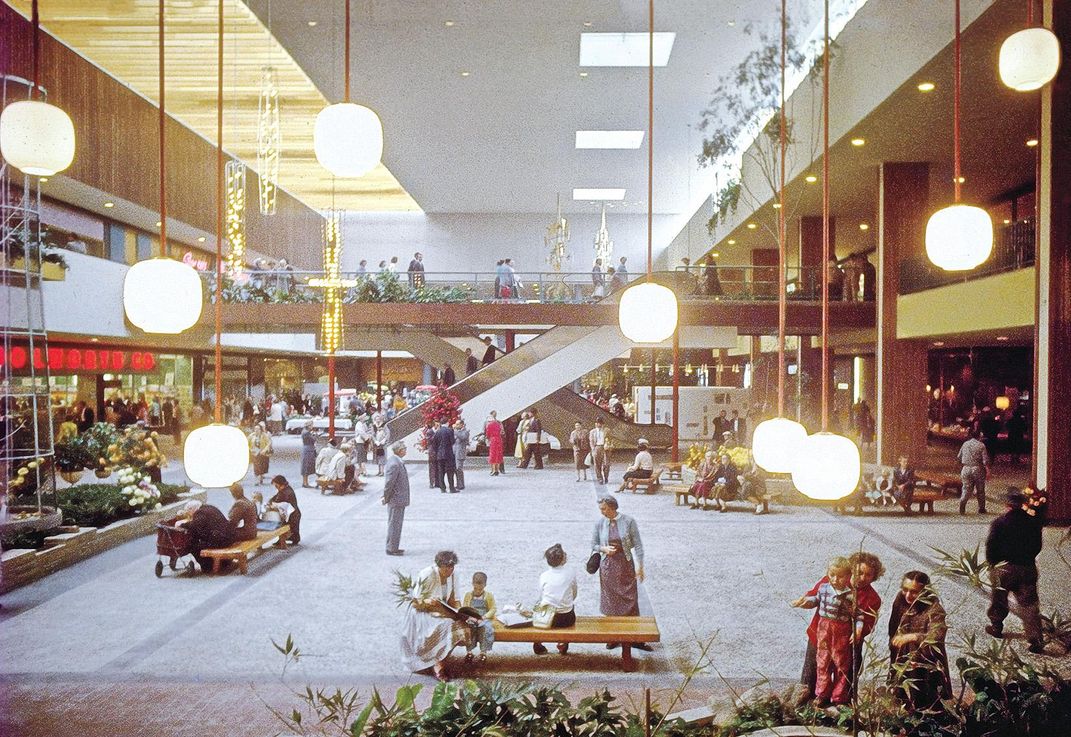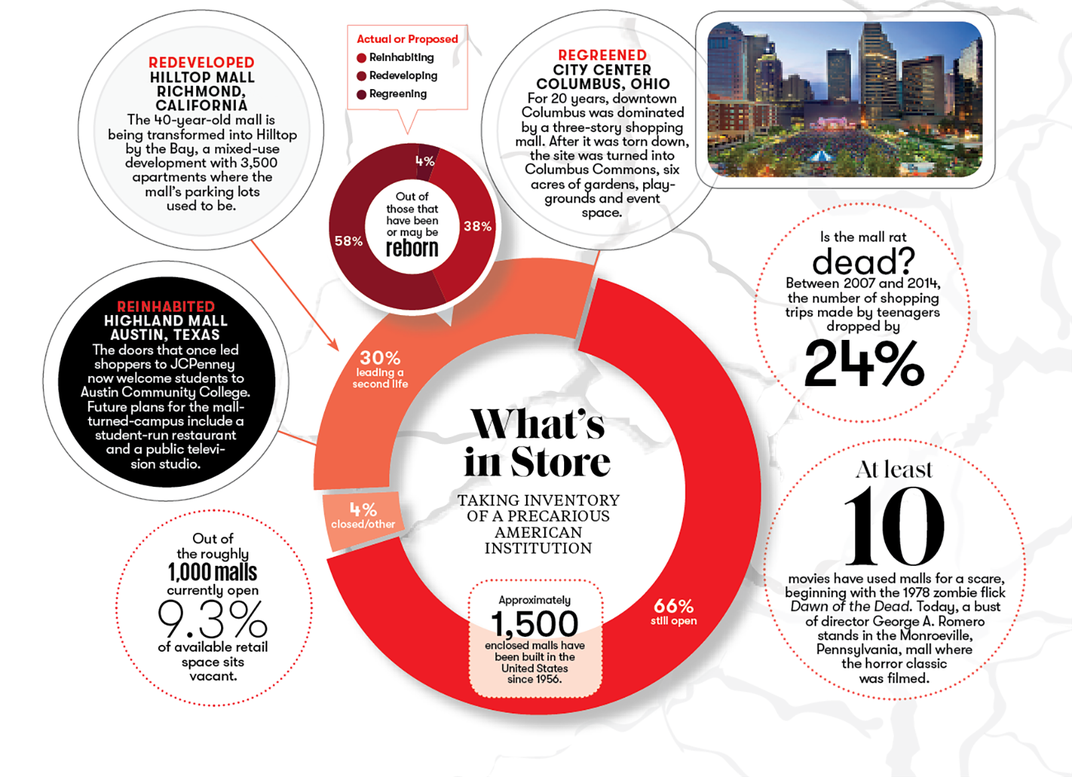The Rise of the Zombie Mall
Hundreds of big retail centers have gone under, but the shop-til-you drop lifestyle isn’t dead yet
/https://tf-cmsv2-smithsonianmag-media.s3.amazonaws.com/filer/e0/fe/e0fe69c3-671e-4d34-b343-45ec1ab57f76/oct2019_d29_prologue.jpg)
“Who wants to sit in that desolate-looking spot?” Frank Lloyd Wright carped of the atrium inside the first enclosed shopping mall, the Southdale Center in Edina, Minnesota.
But 75,000 people rushed there the day it opened in October 1956 and marveled at the 72 stores on two floors, the 800,000 square feet of retail, the 5,200-space parking lot, the 70-degree controlled climate. The Austrian-born architect Victor Gruen, already acclaimed for building the nation’s largest open-air shopping center, had birthed a new phase of American culture.

Over the next 40 years, another 1,500 enclosed malls would dot the landscape, from suburb to shining suburb, insinuating themselves into everyday life so profoundly that just “going to the mall” became a pastime. Hundreds of malls, meanwhile, have closed and been demolished or converted, overtaken by a renewed emphasis on walkable neighborhoods and challenged by that overwhelming force of 21st-century living: online shopping.
But rumors of the shopping mall’s death may be premature, if the mega-mall opening this October is any indication. The $5 billion, three-million-square-foot American Dream complex in northern New Jersey houses a theme park, a water park, a ski and snowboard park, an ice rink, an aquarium, a movie theater and a Ferris wheel. Oh, and stores. Hundreds of luxury and designer stores.
The original developer, Mills Corporation, conceived of the American Dream when Amazon Prime didn’t even exist. The project has faced 16 years of trouble, including a Securities and Exchange Commission investigation of Mills Corp. The company reportedly paid $165 million plus interest to settle the case, and sold the project. A second developer stopped construction when a major lender broke a financing deal. The Triple Five Group—which built the Mall of America in Minnesota in 1992—rescued the project in 2011, but continued to battle environmentalists, neighbors and advocates of vigorous downtowns. Economists voiced skepticism. “I don’t know which is worse—if it fails or if it succeeds,” Jeff Tittel, director of the New Jersey Sierra Club, told New York Magazine in 2011. “If it fails, New Jersey is going to be out of $350 million in taxpayer subsidies. And if it succeeds, it will be the worst traffic, and it will destroy shopping areas in cities and malls all over the state.”
The future of enclosed malls is uncertain enough, and they’ve been around long enough, that symptoms of nostalgia are cropping up more and more in the mainstream. The latest season of the hit show “Stranger Things” features a neon-lit 1980s mall, enabling a new generation to see how teens at the height of the craze hung out—under skylights, on elevators, around fountains full of pennies.

“Don’t romanticize it,” warns Lizabeth Cohen, a Harvard professor of American studies who has written about the rise of shopping malls. Developers built them in white suburbs, far removed from cities and public transportation routes, fashioning castles of commerce for the white middle class. The mallification of America continued through the ’70s, ’80s and ’90s (19 malls opened in 1990 alone). But by the turn of the millennium the Congress for the New Urbanism was worrying aloud about “greyfields”—shuttered indoor malls that fell to an oversaturated market. In 2000, DeadMalls.com began memorializing the fallen.
The Great Recession of 2008 didn’t touch A-grade luxury centers, but it pulverized other tiers of malls. Green Street Advisors, a California-based real estate research firm, says the country’s 37 top-performing malls account for nearly 30 percent of mall value nationwide.
Yet Americans still go to the mall, spending some $2.5 trillion in 2014, according to the International Council of Shopping Centers. A 2018 study from the group—which is, admittedly, paid to promote brick-and-mortar retail—found that three-quarters of teens still prefer physical stores to shopping online. Certainly malls are changing, as the nation does. Paco Underhill, a market researcher and founder of the consulting company Envirosell, points to La Gran Plaza in Fort Worth, Texas, which slumped to 10 percent occupancy before reinventing itself as a Hispanic-themed mall, in a region where 23 percent of the population speaks Spanish.
Underhill once called the early years of this century the “postmall world,” but he now refers not to malls but to “alls,” extravagant facilities that offer almost everything. Life in 2019 moves at the speed of a tap, immeasurably faster than our traffic-beleaguered roads. Why travel among home, job and fun when you can move to a mall and never leave?

The idea is not so different from Victor Gruen’s original vision of all-in-one shopping, which was inspired partly by cozy European town squares. He might like the variety of experiences available to visitors at the massive American Dream, but it’s safe to say he would hate the parking lots, and the impact on downtowns. Gruen had wanted malls to blend in with their surrounding communities; instead, oceans of asphalt isolated them. “I would like to take this opportunity to disclaim paternity once and for all,” the so-called father of the mall said in 1978, two years before his death. “I refuse to pay alimony to those bastard developments.”